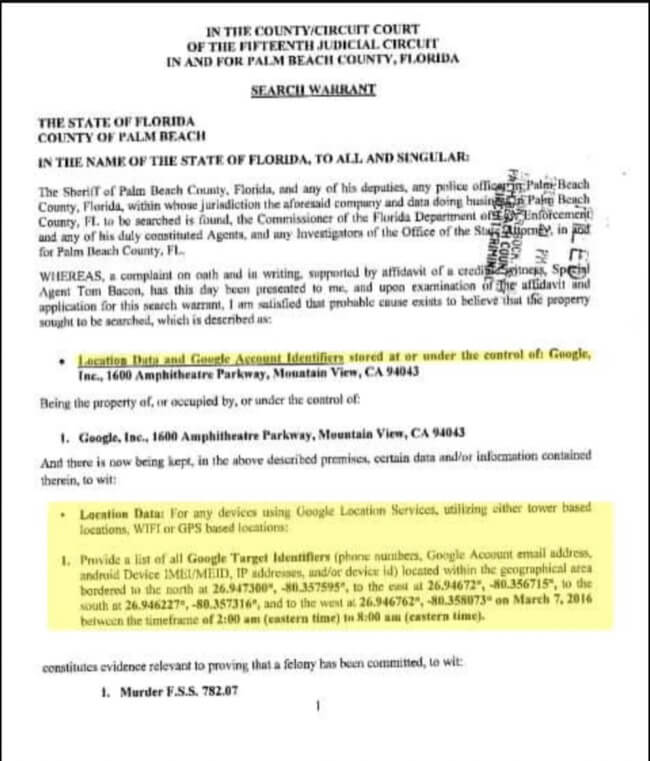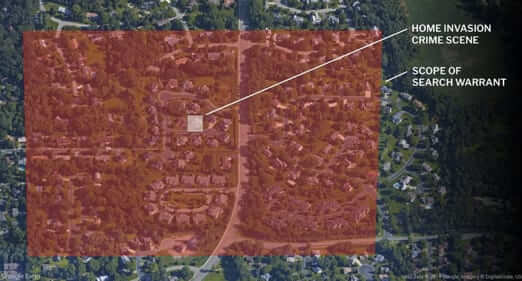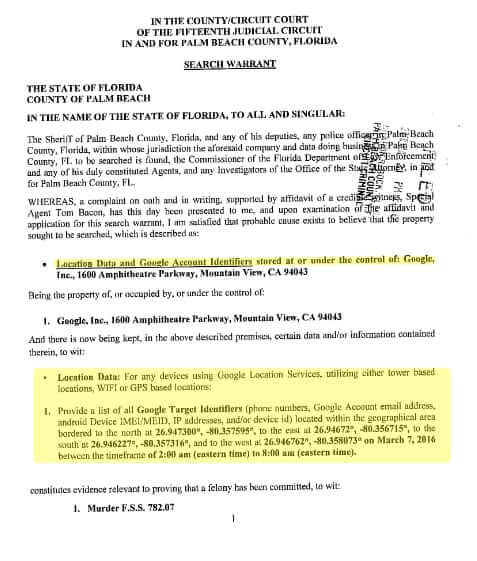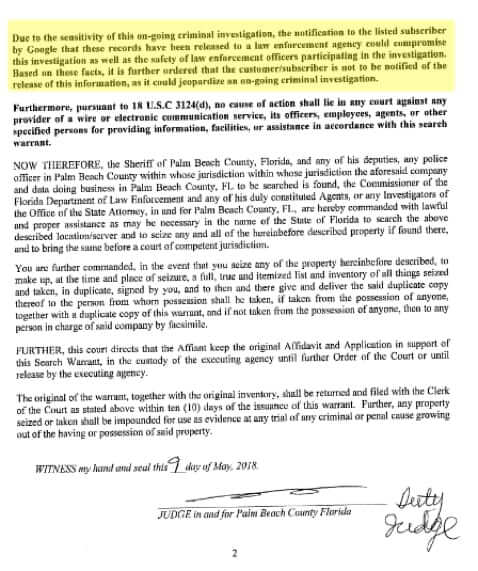
While in the news currently, geofence warrants (also referred to as ‘geo-fence warrants’) are nothing new (and our article includes a real example of a geofence warrant). We first wrote about geofence warrants and how Google is providing law enforcement agencies with lists of devices it has identified as being in the area of a crime scene at the time of the crime almost exactly 3 years ago to the day. Once serving the geofence warrant, and receiving the data from Google’s massive device location database called Sensorvault, law enforcement agencies can then create lists of possible suspects and witnesses, all based on their knowing that the person was simply in the area, based on the tracking of their device.
In order to have the data from Google’s Sensorvault provided to them, law enforcement agencies provide Google with the so-called ‘geofence warrant’ – i.e. a warrant that says, in essence, “provide the device data for all devices that were in the area of a particular location, at a particular time.”
Sample Geofence Warrant
Let’s look at those highlighted paragraphs a little more closely, shall we?
The Internet Patrol is completely free, and reader-supported. Your tips via CashApp, Venmo, or Paypal are appreciated! Receipts will come from ISIPP.
This says that the Palm Beach County, Florida, Sheriff’s department is requiring that Google share with them location data for “any devices using Google Location Services, utilizing either tower based locations, wifi, or GPS based locations” which devices were in the area “bordered to the north at 26.947300°, -80.357595°, to the east at 26.94672°, -80.356715°, to the south at 26.946227°, -80.357316°, and to the west at 26.946762°, -80.358073° on March 7, 2016 between the timeframe of 2:00am (eastern time) to 8:00am (eastern time).”
So anybody using any of Google’s services through which location is recorded who passed near that location in that 6 hour period is fair game.
You will also notice that the demand is for a list that includes phone numbers and email addresses, as well as device identifiers.
Now on to this paragraph:
“Due to the sensitivity of this on-going criminal investigation, the notification to the listed subscriber by Google that these records have been released to a law enforcement agency could compromise this investigation as well as the safety of law enforcement officers participating in the investigation. Based on these facts, it is further ordered that the customer/subscriber is not to be notified of the release of this information, as it could jeopardize an ongoing criminal investigation.” (Emphasis ours)
This has been going on since federal agents first used it in 2016, however the New York Times blew it wide open over the weekend. An unnamed Google employee told the Times that Google now receives as many as 180 geofence warrant requests a week.
Not surprisingly – and, in fact, predictably – this has led to innocent people being charged with some pretty serious crimes.
Just last year, Jorge Molina was charged with the murder of a Phoenix, Arizona resident. According to the Times, the police told Mr. Molina that “they had data tracking his phone to the site where a man was shot nine months earlier.” But, as it turns out, it wasn’t Molina at all – in fact the police later arrested and charged Mr. Molina’s mother’s ex-boyfriend, but not before Molina had spent a week in jail, accused of a crime which he hadn’t committed, because the data from Google Sensorvault had placed Molina’s phone near the crime scene.
And in a case in Minnesota, just in the past 6 months, the geofence warrant was so broad as to location that, according to Minnesota Public Radio, the warrant “had the potential to gather data on tens of thousands of Minnesotans.”

Says former prosecutor Jonathan Jones, now on faculty at Elon University in North Carolina, “We are willingly sharing an awful lot of our lives with Google. But do people understand that in sharing that information with Google, they’re also potentially sharing it with law enforcement?” {TIP note: ..and hackers}>/i>
We actually first told you about law enforcement using Google location for mobile devices over a year ago, when we told you about warrants being served on Google for all mobile devices in a given area. For those of you who still fall into the “I don’t care what they know or track about me, I have nothing to hide” camp, this should be a wake up call.
The Internet Patrol is completely free, and reader-supported. Your tips via CashApp, Venmo, or Paypal are appreciated! Receipts will come from ISIPP.













